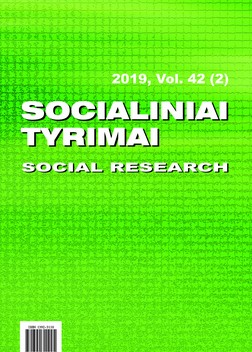Šešėlinės ekonomikos ir oficialiai neapskaitytos ekonomikos sampratų analogija
The Analogy of Shadow Economy and Officially Non-Observed Economy
Author(s): Rūta SakalauskaitėSubject(s): Business Economy / Management, Criminal Law, Economic policy, Law on Economics, Financial Markets, Fiscal Politics / Budgeting
Published by: Vilniaus Universiteto Leidykla
Keywords: Shadow economy; non-observed economy; underground economy; informal economy; illegal economy;
Summary/Abstract: The study examines the analogy of the concepts of shadow economy and non-observed economy. This study is relevant due to the fact that the studies related to shadow economy face the diversity of concepts: it seems that the same phenomenon – companies’ hidden activity – is named differently in various sources. In scientific literature, companies’ hidden activity is commonly named as a ‘shadow economy’ (Enste, 2015, 2018; Gaspareniene, et al., 2014; Goel, et al., 2019; Koufopoulou, et al., 2019; Medina and Schneider, 2018; Novkovska, 2019; Remeikienė, et al., 2017; Sauka and Putnins, 2019; Schneider, 2018a, 2019; Williams and Horodnic, 2015; Zaman and Goschin, 2015). Meanwhile, official statistical institutions, e.g. Statistics Lithuania, Eurostat, World Bank, Organization for Economic Co-operation and Development, use other term to define companies’ hidden activity, i.e. ‘non-observed economy’ (European Commission, International Monetary Fund, Organisation for Economic Co-operation and Development, United Nations, World Bank, 2009; Juškienė, et al., 2004; Lietuvos statistikos departamentas, 2016, 2017). Taking into account that both of these concepts are used in the same context, it can be assumed that the concepts of shadow economy and non-observed economy are identical. However, in order to accept or reject this statement, it is essential to analyze in detail the object of the study – the concepts of the shadow economy and the non-observed economy. Therefore, the purpose of this study is to structure the concepts of shadow economy and non-observed economy and to identify their similarities and differences. It is done by using the following method: the study of concepts is based on a comparative analysis of the types of shadow economy and the areas of non-observed economy. Due to the complexity of economic processes, shadow economy and non-observed economy cover many fields. The types of shadow economy concept which is defined by the author are the following: • The underground economy which covers market output (e.g. undeclared income from legal activities, salaries paid in envelopes, concealed income, concealed value added or other taxes) concealed by legal operators. • The illegal economy covers the production of illicit operators (e.g. drug trafficking, illegal alcohol production, smuggling). • The informal economy covers market and private use output of units that have no obligation to register their activity (e.g. own-use production of households, auxiliaries). Correspondingly, the areas of non-observed economy concept which is used by official statistical institutions are the following: • The underground economy – a legal manufacturing activity that is deliberately concealed from the authorities due to tax evasion, safety at work or other non-compliance. • The illegal economy – the manufacturing activity of goods and services that is prohibited by law or carried out by unauthorized manufacturers. • The informal sector – manufacturing activities of unregistered households or unincorporated enterprises with non-registered employees, that produce market output. • The household production for own final use – the productive activity of households producing goods and services capitalized within the same households.
Journal: Socialiniai tyrimai
- Issue Year: 42/2019
- Issue No: 2
- Page Range: 85-92
- Page Count: 8
- Language: Lithuanian

